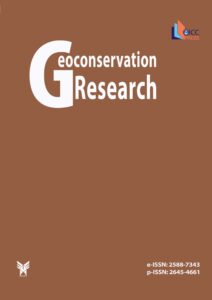Tracking a “Prehistoric Pompeii” , Rhinoland and Crocodilia: New Discoveries and Interpretations Of Ipolytarnóc (N Hungary) Lower Miocene Track Site
Authors
- Laszlo Kordos 1
- Ildiko Meszaros 2
- Imre Szarvas * 3
Abstract
The transnational Novohrad-Nógrád Geopark situated in Northern Hungary and Southern Slovakia has several important Neogene fossil sites developed for geotourism. One of them is the lower Miocene paleontological locality complex at Ipolytarnóc , which has been well known since the middle of the 19th century. The site is the main geotouristic gateway to the geopark, where high-tech interpretation resources explain the geological background and fossil resources to visitors, like the rich shark-tooth-bearing intertidal sandstone, the terrestrial sandstone and rhyolite tuff containing a petrified forest and leaves, and the great number of animal tracks in a relatively small area. Since 2015, the authors have identified several thousand footprints and body impressions, including new fish, amphibian, reptile, bird, and mammal ichnotaxa, among others. Re-interpretation of the paleohabitats identifies interfingering terrestrial (Rhinoland) and intertidal pool (Crocodilia) landscapes. Similar track assemblages of similar age indicate intensive tectonic uplift and fluviatile-lacustrine sediment accumulations in the Western, Central and Eastern Paratethys forced by Neogene African plate movements.
Read the full text of the articleKeywords
Main Subjects
References
Abel O (1935). Vorzeitliche Lebensspuren. G. Fischer, Jena, pp.160–167.
Bartkó L (1985). Geology of Ipolytarnoc. Geologica Hungarica, Series Palaeontologica. 44:1–71.
Beaudoin B & Gigot P (1971). Figures de courant et traces des pattes d’oiseaux assiciees dans la molasse Miocene de Digne, Bases Alpes (France). Sedimentology. 17:3–4.
Böckh H (1902). Report of the director. Magyar Királyi Földtani Intézet Jelentése 1900-ról. p. 33–34. (in Hungarian)
Bräm H (1955). Fährten von Wirbeltieren aus der subalpinen Molasse des Bergsturzgebietes von Goldau. Eclogae Geologicae Helvetiae. 47:406–417.
Fournier M, Agard P & Petit C (2008). Micro-tectonic constraints on the evolution of the Barles half-window (Digne Nappe, southern Alps). Implications for the timing of folding in the Valensole foreland basin. Bulletin de la Société Géologique de France. 179:551–568.
Hably L (1985). Early Miocene plant fossils from Ipolytarnóc, N Hungary. Geologica Hungarica, Series Palaeontologica. 45:73–255.
Hámor G (1985). Geology of the Nógrád-Cserhát area. Geologica Hungarica, Series Geologica. 22:1–307.
Koch A (1903). Tarnócz Nógrád megyében, mint kövült czápafogaknak új gazdag lelőhelye (Tarnócz in Nógrád county, as a new rich finding place for petrified shark teeth). Földtani Közlöny. 33:22–44. (in Hungarian)
Koch A (1904): Pótlék a tarnóczi alsómediterrán homokkő czápafaunájához (Supplement to the lower Mediterranean sandstone’s shark fauna of Tarnócz). Földtani Közlöny. 34:202–203. (in Hungarian)
Kocsis L (2007). Central Paratethyan Miocene shark fauna (Ipolytarnóc, Hungary). Geologica Carpathica. 58:27–40.
Kocsis L (2016). Újabb eredmények az ipolytarnóci cápafogas rétegről, illetve annak faunájáról (New results of the shark teeth-bearing layer’s fauna of Ipolytarnóc). – In Szarvas, I. (ed.): Ősmaradványok nyomában. Ipolytarnóc földtani megismerése I. (Tracing fossils. Geological research of Ipolytarnoc, volume I.) Bükki Nemzeti Park Igazgatóság, Eger. 53–76. (in Hungarian)
Kordos L (1985). Footprints in Lower Miocene sandstone at Ipolytarnóc, N Hungary. Geologica Hungarica, Series Palaeontologica. 46:257-415.
Kordos L & Morgós A (1988). Lower Miocene footprints as studied at Ipolytarnóc in 1986. Földtani Intézet Évi Jelentése. 1986-ról, pp. 493-451.
Kordos L & Mészáros I (2018). Bird tracks the lower Miocene shore of Rhinoland and Crocodilia at Ipolytarnóc, Hungary. Evolução (Revista de Eistoria e Pré-História), Ser 1. Num. 2, p. 38-41. (Edição Especial; As Aves: Evolução, Paleontololgia, Arquezoologia, Artes e Ambientes), Lisboa
Korpás L (2003). Az ipolytarnóci homokkő új szedimentológiai modellje. A vulkáni esemény kronológiája és központjának rekonstrukciója. (The new sedimontological model of Ipolytarnoc, Chronology of the volcanic event and reconstruction of its center. Manuscript, Magyar Karszt- és Barlangkutató Társulat – Bükki Nemzeti Park, Budapest-Eger, pp. 16. (in Hungarian)
Kretzoi M (1950). Az ipolytarnóci lábnyomos homokkő földtani kora és az akvitán kérdés. (The geological age of the footprint-bearing sandstone of Ipolytarnóc and the aquitanian debate). Földtani Közlöny. 80:259–261. (in Hungarian)
Kubinyi F (1842). Nógrádmegyében Tarnócz helység határában található óriásnagyságú kövesült fáról és azt környező kőnemekrõl földisméreti tekintetben. (About the giant petrified tree found at the neighborhood of Tarnócz in Nógrád county and about its surrounding rocks from the perspective of Erath sciences). M. O. T. V. M. 2: 67–70 (only in Hungarian)
Kubinyi F & Vahot I. (eds.) (1853). Magyarország és Erdély képekben. (Hungary and Transylvania in pictures) – Pest. I:5–14. (in Hungarian)
Lambrecht K (1912). Magyarország fosszilis madarai (Fossil birds of Hungary). Aquila. 19:288–315. (in Hungarian)
Lambrecht K (1933). Handbuch der Paläornithologie. Berlin
Lóczy L (1910). Führer durch das Museum der Kgl. ungar. Geolog. Reichsanstalt. Földtani Intézet Népszerű Kiadványai, 1:29–30.
Pálfy J, Mundil R, Renne P, Bernor RL, Kordos L, Gasparik M (2007). U-Pb and 40Ar/39Ar dating of the Miocene fossil tracksite at Ipolytarnóc (Hungary) and its implications. Earth and Planetary Science Letters. 258:160–174.
Panin N, Avram E (1962). Noi urne de Vertebrate in miocenul Subcarpatiler Rominesti. Studia si Cereştari de Geologie, Geofizica, Geogrrafie Romine. 7:455-484.
Szarvas I (2007). Case study of the Ipolytarnoc track site, Hungary. New Mexico Museum of Natural History and Science Bulletin. 42:303–308.
Tardy J, Kordos L & Szarvas I (2003). A global comparative analysis of the palaeohabitat of Tarnoc. VÁTI, Budapest.
Tasnádi Kubacska A (1976). Az ipolytarnóci lábnyomos homokkő őséletnyomai (The ichnofossils of the footprint-earing sandstone in Ipolytarnóc). Földtani Intézet Évi Jelentése 1974-ről., pp. 77-94. (in Hungarian)
Thenius E (1948). Bemerkungen über die angeblichen Anchitherium- und Amphicyonidenfährten aus dem Burdigal von Ipolytarnóc (Ungarn). Sitzungesberichte des Österreische Akademie der Wissenschaften, Mathematisch-Naturwissenschaftliche Klasse 1., 157:223–230.
Vialov OS (1965). Neogene Stratigraphy of the Molasse of the Pre-Carpathian region (in Russian). Naukova Dumka, Kiev
Vialov OS (1966). Sledi zisnedeljatelnosti organizmov i ih paleontologitseskoe znatsenie. Naukova Dumka, Kiev.
Vialov OS (1985). The tracks of Vertebrata in the Lower Miocene of Hungary. Paleontologicheskii Sbornik. 22:71–78.
Vialov OS (1986). Artiodactyl traces from the Lower Miocene of Hungary. Paleontologicheskii Sbornik. 23:63–69.



